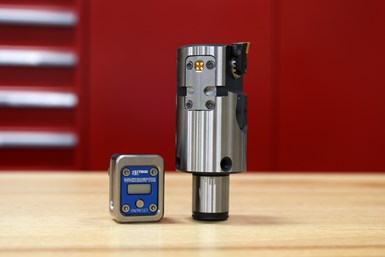Allied Machine & Engineering Expands Range of Boring Tools
Both the 420 (410) and 465 (464) digital boring heads come equipped with a 3ETech docking port for easy digital diameter adjustments.
Share





Allied Machine and Engineering, a leading manufacturer of holemaking and finishing cutting tools for the metal-cutting industry, continues to expand the Wohlhaupter boring tool product line with the launch of the 420 (410) series fine boring heads, as well as the expansion of the 465 (464) series. Both the 420 (410) and 465 (464) digital boring heads are equipped with a 3ETech docking port for easy digital diameter adjustments.
The unbalanced 420 (410) series has a diameter range of 0.787"-1.142" (20.00 mm-29.00 mm), which reportedly makes it the world’s smallest digital fine boring tool with a peripheral cutting edge. The 465 (464) boring heads offer automatic self-balancing and bore diameters from 1.142"-8.071" (29.00 mm-205.00 mm). These boring heads have a special design to minimize the residual imbalance produced by insert holder displacement. As a result, the tools remain stable even with light interrupted cuts throughout the entire machining process and achieve the tightest tolerances and optimum surface quality. Additionally, the insert holder can be rotated for reverse machining jobs.
The tools are available in the non-digital version with vernier scale adjustment or in the digital version for adaptation with the 3ETech digital display for μ-accurate adjustment. Wohlhaupter’s 3ETech digital display module can now be used with all types of precision boring tools, including fine boring with the 420 (410) and 465 (464) series, versatile boring with VarioBore, large-diameter boring with the 538 (537) finish boring cassettes and custom boring tool solutions. The digital display module is docked to the tool, enabling maximum coolant pressure to be used and eliminating the risk of damaging the digital components during operation. Users now only need a single display module for all tools with integrated 3ETech technology, which reduces tooling costs.
Related Content
-
Custom PCD Tools Extend Shop’s Tool Life Upward of Ten Times
Adopting PCD tooling has extended FT Precision’s tool life from days to months — and the test drill is still going strong.
-
Orthopedic Event Discusses Manufacturing Strategies
At the seminar, representatives from multiple companies discussed strategies for making orthopedic devices accurately and efficiently.
-
Form Tapping Improves Tool Life, Costs
Moving from cut tapping to form tapping for a notable application cut tooling costs at Siemens Energy and increased tool life a hundredfold.















.jpg;maxWidth=300;quality=90)






